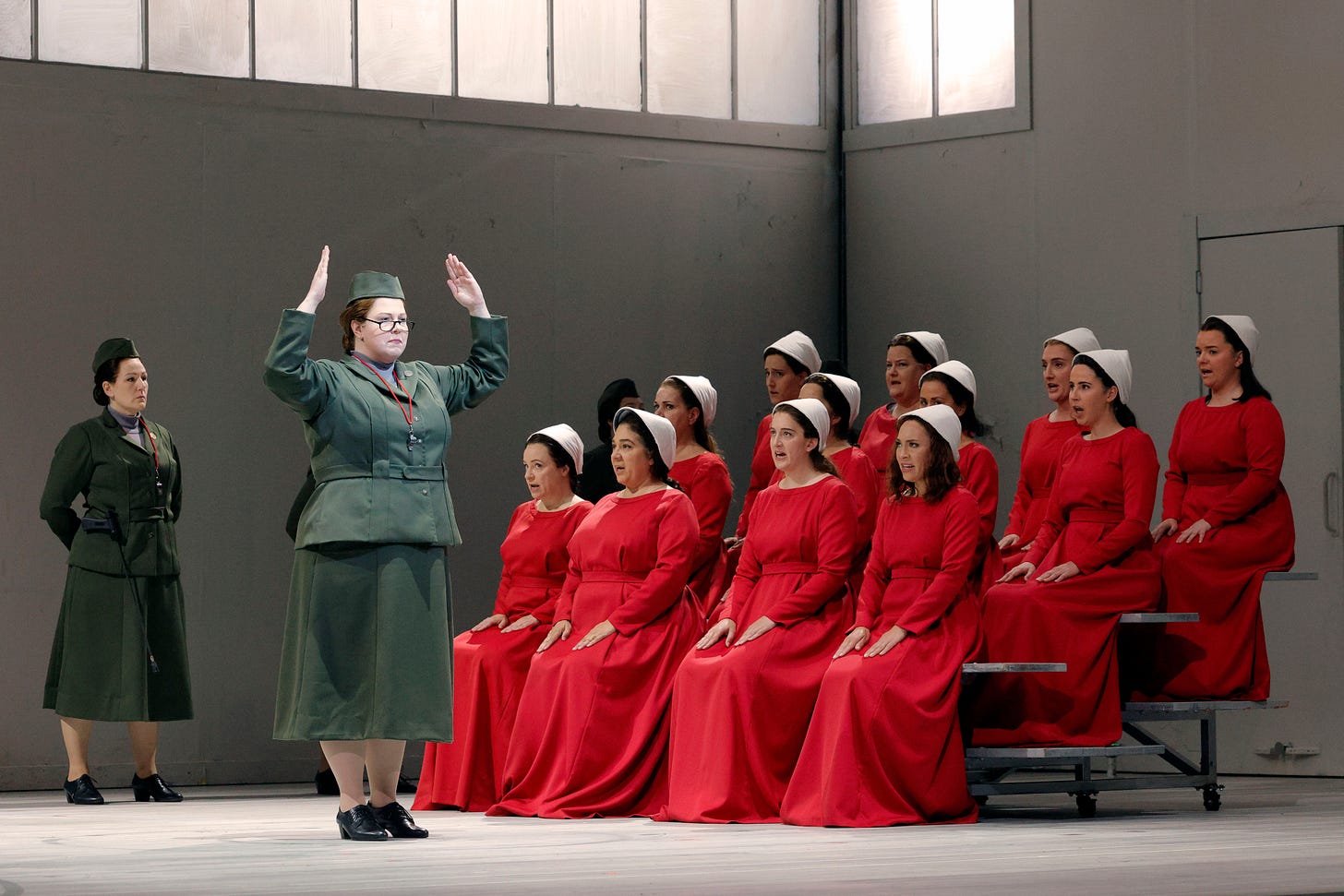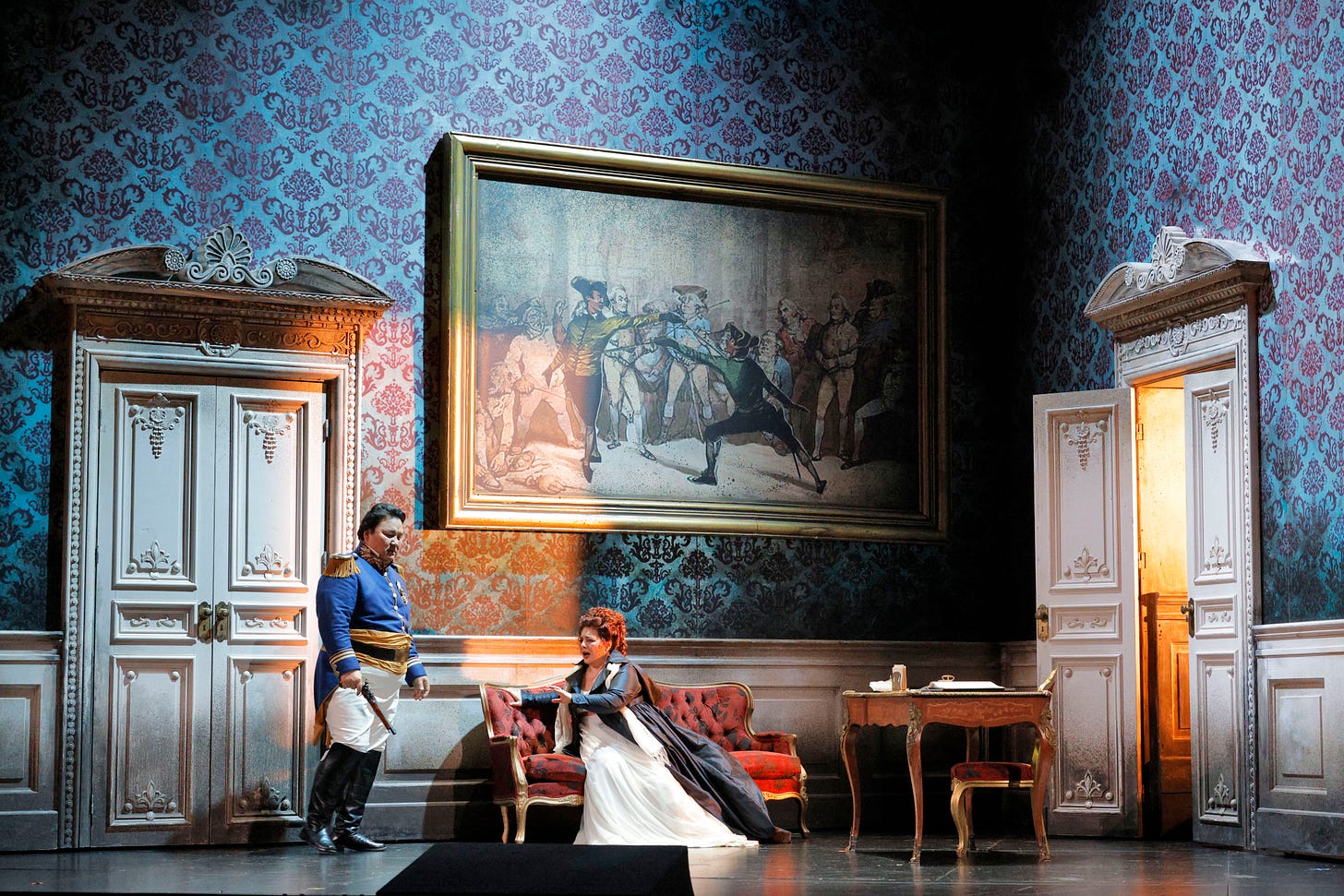Singing in Gilead
In a chillingly pertinent new production, "The Handmaid's Tale" takes the stage at SF Opera
When Margaret Atwood’s award-winning novel The Handmaid’s Tale first appeared in 1985, it must have seemed like an eerie warning cry. Gilead, the dystopian society it depicts so chillingly, had a plausible ring to it. A theocracy in which Biblical transgressions are punishable by death? An elaborate system, inspired by the story in Genesis of Jacob and his wives and handmaids, by which fertile young women are impressed into service to bear children for the elite? An apparatus of grimly enforced social and political control? It could absolutely happen — some day in the future, if we’re not sufficiently vigilant.
And now look where we are. When the Danish composer Poul Ruders’ 2000 opera based on Atwood’s novel took the stage of the War Memorial Opera House on Saturday, one of its most forceful revelations was just how swiftly the guardrails we thought, or hoped, were in place have crumbled.
It isn’t just that the opera feels more pertinent today than it would have in 2020, when the San Francisco Opera canceled its originally scheduled West Coast premiere in the face of the Covid pandemic. It’s that Handmaid is now even more on point than it was in February, when the company announced its 2024-25 season. In the interim, JD Vance has shared his thoughts on childless women in terms that might have been lifted directly from the opera. New and ever more draconian limits have been imposed on women’s health care. Women are to be judged by their fertility, and their reproductive status should be rigidly monitored and controlled by the state is no longer an Orwellian what-if. It’s the explicitly stated belief of one of the United States’ two major political parties.
On opening night, the horrors of the current situation and those of Ruders’ fearless opera seemed to flow back and forth over the footlights, mingling in a dark cocktail of dread and disgust. The piece never shies away from either the bare facts or the implications of Atwood’s premise, and the Opera’s sleek, cogent production doesn’t either. It looks at Gilead head-on, and requires the audience to do the same. The hanged corpses that are on public display for the edification of the population command our attention as well.
All of which is to say that Handmaid is powerful, jarring, well-crafted, superbly executed, and damned hard to sit through. A lot of Ruders’ score is built from thick, densely woven layers of sound; you can feel in your very bones the oppressive weight of Gilead’s power structure. The vocal writing leaves much to be desired — it often drapes itself across the dialogue of Paul Bentley’s libretto in shapeless, talky phrases, and the writing for the militaristic Aunts tends toward the screechy. But Ruders creates a canny harmonic landscape that blends the tonal harmonies of the Time Before (especially in its echoes of “Amazing Grace”) with corrupting dissonances to suggest what society has come to. He also finds room for the occasional burst of lyricism, most memorably in a duet that joins the protagonist Offred (mezzo-soprano Irene Roberts, in a tour-de-force of vocal and dramatic pyrotechnics) with her former self (mezzo-soprano Simone McIntosh, a former Adler Fellow singing with limpid grace).
The American conductor Karen Kamensek, who hasn’t been heard in San Francisco since her company debut a decade ago in Carlisle Floyd’s Susannah, did yeomanly work wrestling this huge concoction, with its oversized cast of characters, into a coherent shape. The Opera Orchestra sounded vivid and rich-hued, and the Opera Chorus, by turns implacable and tender, caught the music’s distinctive heft.
Gilead is a world of ceremony and ritual — some of it stylized, some all too explicit — and director John Fulljames’ production, which plays out on designer Chloe Lamford’s sharp-edged, spit-shined set, gives the drama a gut-wrenching sense of familiarity. We know these people, even if we may not know their particular circumstances. It’s only a short step, Handmaid reminds us, from here to there. The warning could hardly be more timely.
The Handmaid’s Tale: San Francisco Opera, through Oct. 1. www.sfopera.com.
Elsewhere:
Lisa Hirsch, San Francisco Chronicle/SFCV: “an opera of almost unbearable intensity.”
Linda Liu, San Francisco Chronicle: “It has, to date, been the most difficult piece I have ever done,” Roberts told the Chronicle.
Rae Alexandra, KQED: “a faithful yet incredibly innovative rendering of the original story.”
Caroline Crawford, Bay City News: “the story is told brilliantly from start to finish.”
Stephen Smoliar, The Rehearsal Studio: “the unfolding of the episodes begins to feel oppressive long before [the] first act has concluded.”
The Opera Tattler: “the piece is an impressive theater experience.”
The Ballo’s in your court
Verdi’s Un Ballo in Maschera (A Masked Ball), which opened the company’s season on Sept. 6 in a handsome, vibrantly rendered production, seems comfortably faraway to us now. But it wasn’t always so. The libretto, based on the 1792 assassination of Sweden’s King Gustav III, was deemed too incendiary for the Neapolitan censors (you never want to give people the idea that killing monarchs is a way to solve political problems), so the piece was safely, if weirdly, relocated to colonial Boston. It turns out that if the action takes place across the Atlantic, and the assassinated ruler isn’t actually a king, then no harm done.
The San Francisco production, which originated in Rome and is being given in the U.S. for the first time, puts us back in the Swedish court, as most contemporary productions do. Set designer Federica Parolini conjures up vertiginous, high-ceilinged spaces (wonderfully sumptuous for the palace, oddly airy for what is supposed to be the cramped, shadowy hut of the fortune-teller Ulrica), and Silvia Aymonino’s opulent costumes boast enough brocade to keep a dozen seamstresses in business for a month.
That’s what you want for an opening-night blowout, and the cast largely rose to the occasion. Soprano Lianna Haroutounian (Amelia) and tenor Michael Fabiano (Riccardo) are both frequent and well-beloved visitors to the War Memorial, and both of them sounded terrific, especially in the great love duet of Act 2. But the exciting news was the company debut of Amartuvshin Enkhbat, a Mongolian baritone who brought robust vocal tone and suave expressivity to the third point of the central love triangle (Renato or Count Anckarström, depending which version of the opera you’re thinking of).
Director Leo Muscato handles the romantic ardor of the piece dexterously enough. What I missed in his staging was an appreciation for the vein of bitter irony that is one of the opera’s principal flavors. Ballo is an opera in which laughter features prominently, but not the sort of light-hearted clowning that shows up too often in this production. (Oscar, the pageboy, is admittedly amusing, but that’s mostly because he never knows what’s going on.) Instead, Verdi specializes in a kind of dark, sardonic mockery. In Act 1, Riccardo makes fun of the fortune-teller Ulrica’s dire prediction of his death, blithely unaware that it will come true before the end of the evening. Stronger yet is the end of Act 2, where Renato is exposed by the conspirators as a cuckold and Verdi writes their scornful guffaws directly into the score.
In general, the dramaturgy of public ridicule is a Verdian specialty; think of the unspeakable pathos of Rigoletto pleading for his daughter’s safety in “Cortigiani!” or the excruciating final tableau of Act 3 of Otello. But it rises to its peak in Ballo. Renato’s humiliation in Act 2 — its effect still blistering after intermission as he launches into the ferocity of the aria “Eri tu” — should ideally be almost too painful for the audience to witness; here it fell flat.
Un Ballo in Maschera: San Francisco Opera, through Sept. 27. www.sfopera.com.
Elsewhere:
Lisa Hirsch, San Francisco Chronicle: “any production this well sung and well directed deserves the largest possible audience.”
Steven Winn, SFCV: “for all its darkness, this Ballo came off with luminous grandeur and touches of humor.”
Caroline Crawford, Bay City News: “Michael Fabiano’s soaring, bright tenor fleshed fully the devil-may-care attitude of the king.”
Michael Anthonio, Parterre Box: “overall, this was a superb achievement and a thrilling season opener for the San Francisco Opera.”
Stephen Smoliar, The Rehearsal Studio: “last night…felt like an interminable slog.”
The Opera Tattler: “the 2016 production from Teatro dell'Opera di Roma was decidedly lackluster.”
So what are we doing here?
I’m not entirely sure yet, to be frank. When I retired from the San Francisco Chronicle in May, after 36 happy and satisfying years covering classical and new music in the Bay Area, I knew it was time to lay down my pen for at least a while. But I also knew that I had to keep attending live musical events — because obviously — and that I wouldn’t be able to spend more than about 15 minutes in the concert hall or opera house without formulating ideas, reactions, arguments, and judgments. It's what I do. And it followed in turn that I had to find some outlet for those thoughts, lest they back up and start keeping me awake at night.
Thus, On a Pacific Aisle. [Note: At the moment the title is aspirational; Substack’s software seems determined not to let me change the name of the newsletter. I live in hope of defeating the gremlins by next week, if not sooner.] The title is cannibalized from a blog I maintained spottily for several years back when blogs were A Thing. At the time, I was channeling most of my musical thoughts into the pages of the Chronicle, and the blog was a parking space for various quips and quirks that had nowhere else to go. Now I’m without a regular mainstream venue, so the shape of the new venture promises to be rather different. Precisely how remains to be seen, but as Michael Tilson Thomas always likes to say, “watch this space.”
Cryptic clue of the week
I’m not about to write a regular column without any crossword content; I mean, that just goes without saying. Here’s one from the most recent Out of Left Field cryptic by Henri Picciotto and me:
Small, pale bird (4)
4 is the enumeration; it tells you that the answer is 4 letters long. Answer coming next week.
Coming up
• San Francisco Symphony: Assuming the Symphony Chorus doesn’t make good on its recent strike authorization vote, Esa-Pekka Salonen is due to open his final season as music director with Verdi’s Requiem. The Chorus has been thriving under the leadership of its new director, Jenny Wong, and I’m looking forward to hearing the ensemble in action. Sept. 19-21, Davies Symphony Hall. www.sfsymphony.org.
• California Symphony: The Walnut Creek orchestra opens its season under music director Donato Cabrera with Beethoven’s Ninth Symphony. It’s not the most innovative programming choice, but the lineup of vocal soloists — Laquita Mitchell, Kelley O’Connor, Nicholas Phan, and Sidney Outlaw — is first-rate, and Louise Farrenc’s Overture No. 2 promises to be a savory curtain-raiser. Sept. 21-22, Lesher Center for the Arts, Walnut Creek. www.californiasymphony.org.








